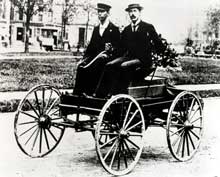You may have been singing those words this week, but this item is not about the most popular movement in the best-known oratorio of Britain’s most famous German composer. It’s about one of the least-well known pioneers in the automobile business.
Charles Brady King was born February 2, 1869 on Angel Island in San Francisco Bay. With a fresh engineering degree from Cornell he went to Detroit and took a job with the Russell Car & Foundry Company, a rail car manufacturer. At the 1893 Columbian Exposition in Chicago he became enamored of a self-propelled runabout exhibited by a German named Daimler. Charles B. King decided to build his own car.
In 1895, H.H. Kohlsaat, publisher of the Chicago Times Herald, staged a race for motor cars in his city. King’s car was not ready, but King was there, on the Benz entry. When its driver passed out from extreme cold, King took the controls and drove to the finish, losing out only to Duryea. King’s own car was complete and running in March of 1896, and, with his helper Oliver Barthel aboard, King made his maiden journey through the streets of what would become Motown. Another pioneer, whose car wasn’t running until three months later, followed on a bicycle.
Lacking the resources to make a commercial success of it, King dismantled his car and sold it, and went to sea as a machinist’s mate in the Spanish-American War. In 1902 he became chief engineer with the Northern Manufacturing Company, which made the Northern automobile. He left in 1908 to study art and architecture, but by 1910 he was back in the motor industry, and in February 1911 launched the King Motor Car Company in Detroit. Its first product was the King Silent 36, a four-cylinder 35-hp car selling for $1,565. For 1915, a V8 model joined the four, with a smaller engine than Cadillac’s but selling for about 60 percent of its price.
American cars had global reach even before World War I. Salmons and Sons, the English coachbuilders, had the British franchise for King by 1913, importing chassis for their own bodywork. A Salmons-bodied King landaulet was rescued from a scrapyard and is currently undergoing restoration of body and engine. Down under in Australia, collector John Ryder is seeking parts for the King V8 he found in the outback.
By 1919, King had adopted a radiator design that mimicked the shape of the car’s nameplate. This Model G Foursome belongs to today’s King of Kings, Leonard King of Maryland, who has a regal collection of the marque. In addition to the Foursome his cars include a 1913 Model B Roadster, a 1914 Model C Touring, 1916 Model E Touring, 1918 Model F Touring, 1919 Model G Roadster and Touring, and an unrestored 1923 Model L Touring.
The King automobile was out of production by the end of 1923, but Charles Brady King lived on to 1957. Among his many inventions was the spark intensifier, sold even today at fairs and carnivals.
Thanks to UK historian Michael Ware as well as St. Louis Bureau Chief Fred Summers, John Ryder and Leonard King for the photos that illustrate this CarPort.

